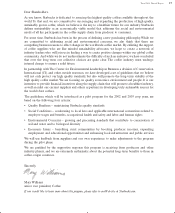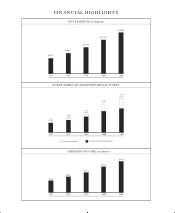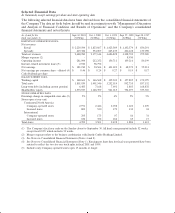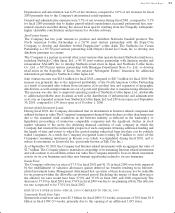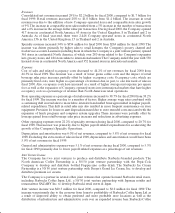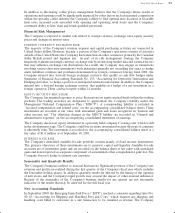Starbucks 2001 Annual Report Download - page 11
Download and view the complete annual report
Please find page 11 of the 2001 Starbucks annual report below. You can navigate through the pages in the report by either clicking on the pages listed below, or by using the keyword search tool below to find specific information within the annual report.
Fiscal 2001 Annual Report 27
In addition to fluctuating coffee prices, management believes that the Company’s future results of
operations and earnings could be significantly impacted by other factors such as increased competition
within the specialty coffee industry, the Company’s ability to find optimal store locations at favorable
lease rates, increased costs associated with opening and operating retail stores and the Company’s
continued ability to hire, train and retain qualified personnel.
Financial Risk Management
The Company is exposed to market risk related to foreign currency exchange rates, equity security
prices and changes in interest rates.
FOREIGN CURRENCY EXCHANGE RISK
The majority of the Company’s revenue, expense and capital purchasing activities are transacted in
United States dollars. However, because a portion of the Company’s operations consists of activities
outside of the United States,the Company has transactions in other currencies,primarily the Canadian
dollar, British pound and Japanese yen. As part of its risk management strategy, the Company
frequently evaluates its foreign currency exchange risk by monitoring market data and external factors
that may influence exchange rate fluctuations. As a result, the Company may engage in transactions
involving various derivative instruments, with maturities generally not exceeding five years, to hedge
assets, liabilities, revenues and purchases denominated in foreign currencies. During fiscal 2001, the
Company entered into forward foreign exchange contracts that qualify as cash flow hedges under
Statement of Financial Accounting Standards No. 133,“Accounting for Derivative Instruments and
Hedging Activities,” to hedge a portion of anticipated international revenue.In addition,the Company
entered into a forward foreign exchange contract that qualifies as a hedge of a net investment in a
foreign operation.These contracts expire within 14 months.
EQUITY SECURITY PRICE RISK
The Company has minimal exposure to price fluctuations on equity mutual funds within the trading
portfolio. The trading securities are designated to approximate the Company’s liability under the
Management Deferred Compensation Plan (“MDCP”). A corresponding liability is included in
“Accrued compensation and related costs” on the accompanying consolidated balance sheets.These
investments are recorded at fair value with unrealized gains and losses recognized in “Interest and
other income, net.” The offsetting changes in the MDCP liability are recorded in “General and
administrative expenses” on the accompanying consolidated statements of earnings.
The Company also has an equity investment in a privately held company, Cooking.com, which is still
in the development stage. The Company could lose its entire investment because this type of company
is inherently risky.The investment is recorded on the accompanying consolidated balance sheet at a
fair value of $1.6 million as of September 30, 2001.
INTEREST RATE RISK
The Company’s diversified available-for-sale portfolio consists mainly of fixed income instruments.
The primary objectives of these investments are to preserve capital and liquidity. Available-for-sale
securities are of investment grade and are recorded on the balance sheet at fair value with unrealized
gains and losses reported as a separate component of accumulated other comprehensive gain/ loss.The
Company does not hedge its interest rate exposure.
Seasonality and Quarterly Results
The Company’s business is subject to seasonal fluctuations. Significant portions of the Company’s net
revenues and profits are realized during the first quarter of the Company’s fiscal year, which includes
the December holiday season. In addition, quarterly results are affected by the timing of the opening
of new stores, and the Company’s rapid growth may conceal the impact of other seasonal influences.
Because of the seasonality of the Company’s business, results for any quarter are not necessarily
indicative of the results that may be achieved for the full fiscal year.
New Accounting Standards
In September 2000, the Emerging Issues Task Force (“EITF”) reached a consensus regarding Issue No.
00-10, “Accounting for Shipping and Handling Fees and Costs,” which requires any shipping and
handling costs billed to customers in a sale transaction to be classified as revenue. The Company

